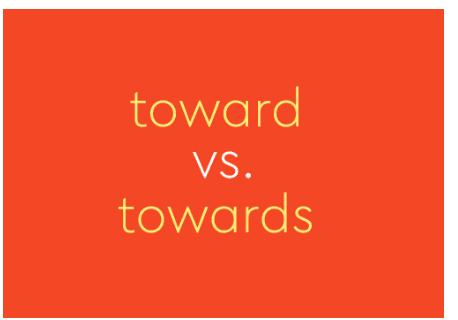Inching Closer or Taking a Leap: A Look at 'Towards' and 'Toward'

Let's say you're writing a formal email to a senior colleague, and you get stuck at "towards" or "toward". Does it matter which one you choose?
English is full of such confusing words, and today we're going to look at one such pair of words — toward vs towards. This blog aims to help you get a clear understanding of the use of toward vs towards, with easy examples.
What are Prepositions?
Prepositions are small yet important tools in English. They connect and establish relationships between words within a sentence. They provide context — pointing to time, direction, location, or manner. In, on, at, for, with, to, etc. are some of the most common prepositions.
For instance, in "He arrived at noon", 'at' signifies time.
Prepositions can also change the meaning of a sentence. Look at these two sentences:
1. "The cat is on the table."
In this sentence, the preposition "on" indicates the location of the cat. The cat is physically located on the surface of the table.
2. "The cat is under the table."
Here, the preposition "under" changes the meaning. The cat is positioned below or beneath the table.
To learn more about prepositions and their important role in English grammar, watch this informative YouTube video. The Clapingo Blog has many helpful articles on grammar, common mistakes, confusing homophones, and more. For example, check out this blog on the proper usage of the prepositions 'To' and 'For'.
Towards or Toward: The Basics

The words 'towards' and 'toward' mean the same thing. They both indicate direction or motion to a place, point, or situation.
In terms of usage, 'towards' is more common in British English. 'Toward' is typically used in American English. However, in India, where we follow British English, you’ll mostly see ‘towards’.
That said, neither form is incorrect in any version of English. It’s just about regional preferences. To illustrate with examples:
"He walked towards the market."
"She ran toward the bus stop."
Both sentences present the same meaning using different words based on regional usage – ‘towards’ and ‘toward’.
Regional Variations: British vs American English
India, being a former British colony, mostly follows British English. This is reflected in our spelling, vocabulary, and even preposition usage.
In British English, 'towards' is used to indicate direction. However, in American English, 'toward' performs the same function. It's important to remember that both forms are correct; it just depends on the region you're communicating in.
Common Mistakes and How to Avoid Them
Here are a few common errors that we often make while using towards/toward and ways to correct them:
1. Incorrect: She walked towards to the market.
Correct: She walked towards the market.
Tip: Remember, use 'towards' as a preposition indicating direction or approach.
2. Incorrect: He ran towards quickly to catch the bus.
Correct: He ran toward the bus quickly.
Tip: Use 'toward' before indicating speed or manner of motion.
To avoid these mistakes, keep practicing sentences using both 'toward' and 'towards'.
How Clapingo Aids Your English Learning Journey
Do you sometimes struggle to speak English fluently? Clapingo can assist you! We provide personalized coaching to improve your use of prepositions and overall English speaking skills. Our native English tutors simplify grammar rules and offer a 5-step course to help you become proficient in spoken English in a supportive learning environment.
You can even take an instant demo with Clapingo!
To Sum Up
Understanding the minor difference between 'toward' and 'towards' can improve the fluency and accuracy of spoken English.
'Toward' is generally used in American English, while 'towards' is more common in British English. Remember, both convey a similar meaning and can be used interchangeably without changing the meaning of your sentence.
As a final note, remember that every little step counts in your journey towards masterful spoken English. With persistent effort and practice, you will undoubtedly reach your goal. Start your English learning journey with Clapingo to get a headstart.
FAQs
1. What is the difference between ‘toward’ vs ‘towards’ in English grammar?
"Toward" and "Towards" are both prepositions used to indicate direction or movement in relation to something else. The difference lies more in their geographical usage rather than grammar. "Toward" is commonly used in American English, while "Towards" is preferred in British English, which is traditionally followed in India.
2. Can we use ‘toward’ and ‘towards’ interchangeably?
Yes, you can use 'toward' and 'towards' interchangeably without affecting the grammatical correctness of your sentence. The decision between the two depends on the form of English you're using (American or British) or simply personal preference. In India, following the UK convention, 'towards' is more frequently used.
3. Is one form more formal than the other when comparing ‘toward’ vs ‘towards’?
Neither form – 'toward' or 'towards' – is more formal or informal than the other. They both carry the same meaning and connotations; their usage merely depends on regional dialects of English. So whether you're speaking casually with friends or presenting at a business meeting, either term can be appropriately used.
You may want to read.
Was vs Were: Gaining Insight into the Proper Use and Application
Comments
Your comment has been submitted